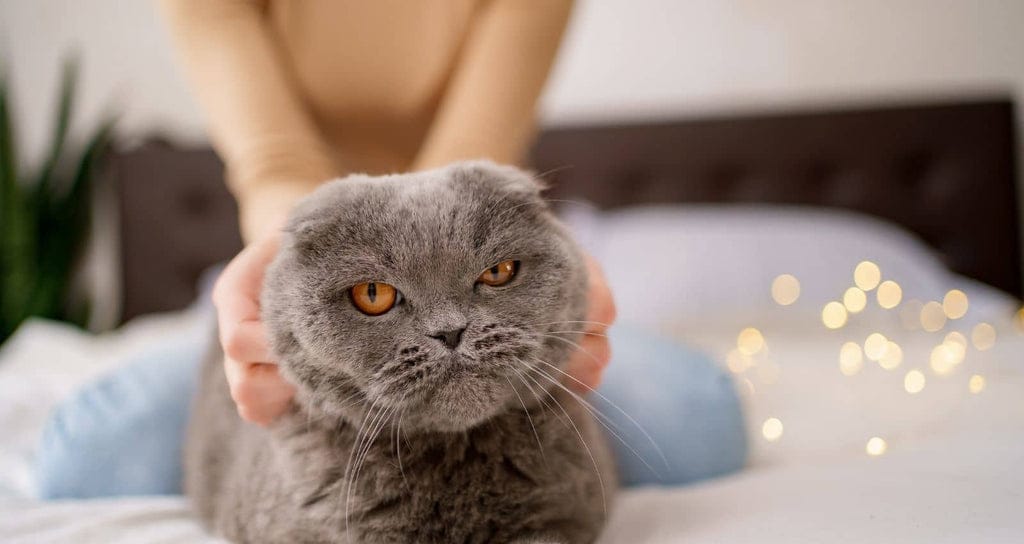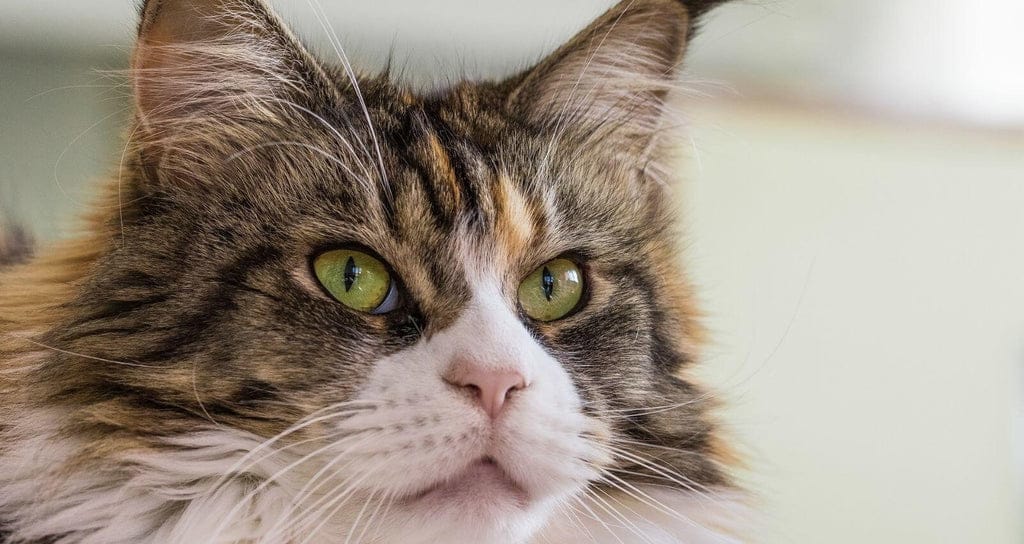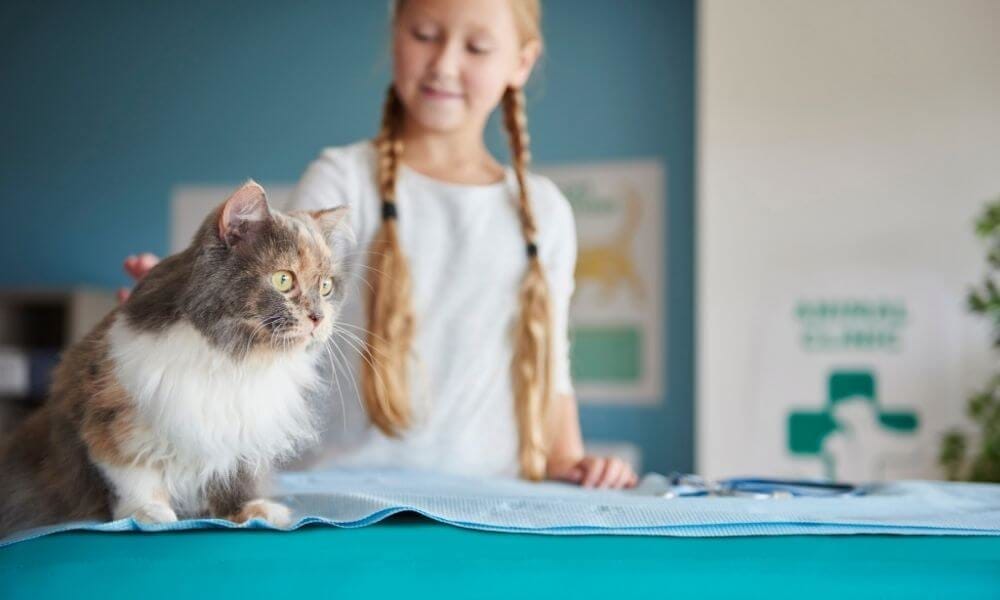FELINE SHELTING: WHAT CAUSES IT AND WHEN SHOULD I BE CONCERNED?
Cats are the best pets. They are charming, cuddly, endlessly fun and are adorable when resting. But there is one thing that continues to discourage feline owners: the constant loss of cat hair.

While hair loss is completely natural, sometimes your cat loses even more hair than normal. We're going to review some common factors that may cause your cat to shed more hair than usual.
WHY DO CATS LOSE THEIR HAIR AND IS IT NORMAL?
You're cuddling your cat and you see that your t-shirt is completely covered in hair. Or you go to relax on the couch and realize that you can tell exactly where your cat has chosen to sleep because it is now covered in hair. This may seem a bit excessive and worrying - or maybe just annoying. However, hair loss is completely normal among felines!

While each feline sheds a different amount of hair, pet cats certainly shed hair every day. They also have two more significant hair loss cycles per year. When you welcome a cat, you recognize above all that its hair will certainly end up on the furniture, the floor and even on your clothes.
This is one of the daily difficulties of living with a feline, which is why many cat owners equip themselves with hair rollers and use vacuum cleaners to collect their pet's hair from the floor on a daily basis.

WHAT IS THE NORMAL LEVEL OF HAIR LOSS FOR CATS?
Each cat sheds more or less, depending on its genetics, breed and hair size. You'll find that you can usually remove a handful or two of feline hair from your cat each time you brush it. Despite all that fluff, your cat will definitely keep a soft, shiny coat.
Here are some indications that the fall is irregular:
- Its thickness becomes much thinner than normal.
- You may see swollen or irritated skin under his fur.
- Your feline starts throwing up more hairballs than usual.
- You find feline hairballs in your home.
- Your cat grooms itself excessively in certain areas of the body.
-
His fur seems really deteriorated

Felines who lose much more than the breed average
You'll see even more fur fluff in your home if your pet cat has long hair or a double coat.
Many breeds shed more frequently than others due to their abundant fur.
Here are some of these breeds that shed a lot:
- Ragdoll
- Persian
- Maine Coon
- Norwegian Forest Cat
- Burmese
- Manx

Cats whose hair does not shed much
For cat lovers who are a little more particular about shedding, fortunately there are feline breeds that have shorter, finer coats. You will notice that the following types of cats shed much less.
- Bengal
- Mumbai
- Siamese
- Cornish Rex
One feline you might be shocked to find on this list is the Siberian. This regal-looking feline has quite an enormous coat. However, this cat is known to shed less hair than the average cat and is also hypoallergenic.
Their weather-resistant coat produces much less of the healthy protein Fel d 1 (the one that triggers allergic reactions) than some other cats.

And you can't forget the hairless felines!
- The Sphynx,
- the Peterbald,
- the Donskoy
and various other Sphynx hybrids have at most a little peach fuzz. These types are perfect for families who don't want to see hairs on their freshly folded laundry. It's essential to keep in mind that hairless felines require a little extra work.
These pet cats are sensitive to the sun. Their skin also becomes quite oily, leading to skin inflammation and acne if they are not properly bathed and groomed.

WHY DOES MY CAT LOSE SO MUCH HAIR?
If your cat is losing hair, don't worry too much. Unless you notice patches of hair or red skin, your cat's shedding is a normal part of being a feline! However, there are a few reasons why you might discover more shedding than usual.
The time of year
Although cats lose hair all year round, the loss accelerates in certain seasons. In winter, cats keep a thicker coat. As soon as the weather warms up in spring and the days get longer, felines begin to shed their extra fur.

Wellness issues
Many health and wellness issues can cause your feline friend to shed even more hair than normal.
These issues may include:
- Allergic reactions
- Ticks
- Microbial infections
- Bumps
- Intestinal diseases
- Skin conditions

Poor quality food
Cats maintain a healthy coat through proper grooming and nutrients they get from a balanced diet. The food you feed your cat should include a high-quality protein source first and foremost.
Without these components, it is highly likely that your cat will not receive the proper nutrients it needs to maintain its healthy and balanced coat. Additionally, a cat having an unwanted diaper is often a sign that other things are wrong.

Stress or anxiety
Some cats actually shed more when they are anxious or stressed.
Anxiety causes hair loss because the cat's muscle mass is certainly tense when it is worried. This results in the roots of some hairs being released.
Age
Just like us, older cats are a little less adaptable. This can make grooming certain areas a little more difficult for some older felines. When they can no longer lick certain spots as successfully, that spot may deteriorate a little more since they can't maintain their furs and keep the spot clean.

When cats are overweight, the same thing can happen. Overweight felines may have difficulty reaching certain areas, especially the spot just above their tail. You will notice that your obese cat is shedding a little more hair than usual because he cannot clean himself effectively.
Hormonal changes
Hormonal changes that occur during pregnancy can cause cats to lose more hair than normal. The majority of hair loss occurs on the mother's belly, making it easier for kittens to settle in to nurse.

HOW CAN I PREVENT MY CAT FROM LOSSING ITS HAIR?
Your cat will always shed, especially if it has more fur. If you are allergic to cats or can't stand seeing cat hair, you may want to consider a hairless breed.
Shampoo for cats against hair loss
There are cat shampoos that advertise much lower shedding and stronger hair. Most of the best cat shampoos certainly contain omega-3 or mega-6 fatty acids, which improve hair follicles and promote healthy, balanced fur. Your feline will always lose hair, but you may notice that it loses a little less when you use this type of product.

Bathe your cat once a month
The problem with cat hair shampoos is that most of them require you to bathe your cat. Not only is this a constant problem (and can leave you with battle wounds), but it's not healthy to bathe a feline frequently. We recommend bathing a cat only once a month, and only if necessary.
To help your feline through the process, add CBD oil to their food beforehand. This can help him relax a little and feel a little more relaxed.
Offer them calming treats
Speaking of CBD, a schedule of CBD treats can be a wonderful method to reduce your cat's shedding. If he is shedding due to a difficult situation or distress, CBD treats can help calm him down and allow him to be much less stressed. This will ensure that your feline does not lose as much hair due to stress.

CBD is a non-intoxicating phytocannabinoid, which simply means that it is a substance normally found in hemp that will not get your feline high. There is no THC, so your feline won't experience any of its negative side effects. On the contrary, your cat will certainly feel all the benefits of CBD when it maintains its body's endocannabinoid system (ECS).
The endocannabinoid system is what allows your cat (and all animals) to maintain homeostasis and overall well-being. The ECS has endocannabinoid receptors in all of its systems. These include the nerves, the gastrointestinal system, as well as the immune system. When CBD interacts with the receptors, it can have a favorable impact on your cat's body and mind.
CBD cat treats contain salmon oil, making them even more helpful for your cat's fur. Salmon oil contains omega-3 fatty acids, which promote healthy, balanced skin and a healthy, balanced coat. You may notice a difference in your cat's coat if you give them CBD treats frequently!
Brush your feline regularly

Regular brushing is generally one of the most effective ways to limit your cat's health problems.
When you comb your cat, you pick up all of its loose hairs. If you brush your cat regularly, you will notice over time that there is less hair on your clothes and furniture.
Invest in a quality long-bristle brush. The ropes penetrate deep into your cat's fur and remove loose hair and dander. Some licking brushes are specially designed for long-haired cats. Their barbs are long enough to penetrate their upper coat and reach the lower hairs.
There are also deshedding brushes that specifically target your cat's bottom coat, removing extra loose hair.
Some cat owners like to use rubber gloves. They can help remove hair and dander quite easily. Wash them with soap and warm water after each use. Let them dry completely before using them again.
Keep Them Hydrated

A dehydrated cat can lose even more than normal, and many cats are vulnerable to dehydration. Cats are indeed very attached to their water source.
If you notice that your cat is lethargic, falls regularly and his water is not affected, it is time to try a new technique to get him to drink. Felines love running water, which is why you often see them drinking from toilets and sinks. If your cat is fascinated by running water, try a cat water fountain.
Likewise, make sure your feline's bowl is clean. If your cat's bowl is full of hair and other pollutants, he may refuse to drink from it. Dehydration is really annoying for cats, so don't let them go without water for too long.
Adjust their diet

Cats who eat low-quality foods are deprived of many of the essential active ingredients that keep them and their coats healthy and balanced. These are omega-3 and omega-6 fats, as well as taurine.
Taurine is an amino acid that felines need to stay healthy but don't produce themselves. It should remain in every type of feline food your kitten eats.
If your cat is allergic to their food, they may also start to lose more hair. A lot of allergic reactions to cat foods come from carbohydrates. The cheapest cat foods replace healthy ingredients with carbohydrates and other "fillers" like cornmeal.
If you notice that your cat's food contains a lot of these ingredients, try switching brands to one with even more protein and less filler with no nutritional value.

Use fatty acids in their diet
You can also try adding CBD oil to your cat's daily food. CBD oil is blended with hemp seed oil, which contains all the omegas your feline needs to maintain healthy, balanced skin and a healthy coat.
Not sure how much CBD oil to give your cat? We recommend 0.25 mg of CBD per 1 additional pound of body weight. This means that a 10-pound cat should take 2.5 mg of CBD every 8 hours or once a day.

If your feline is struggling with an illness and its side effects, you can try giving him a stronger dosage every 8 hours.
Check frequently for fleas and mites
Pests and insects - mites, fleas, ringworm, etc. - certainly irritate your cat, causing it to excessively damage and attack certain areas. Extra grooming will definitely result in more shedding.
You should contact a veterinarian immediately if you notice that parts of your cat's body have significantly less hair or are missing patches of fur.

Help your cat stay energetic
Daily exercise will definitely keep your cat fit and adaptable enough to groom every part of its body. Overweight cats may have difficulty cleaning certain areas, leading to poor skin and coat health.
This leads to increased dandruff and hair loss. By keeping your cat healthy and balanced, you will allow them to brush themselves properly and clean those difficult areas.
WHEN SHOULD I GO TO THE VETERINARY FOR MY CAT’S HAIR LOSS?

Hair loss is completely normal for the majority of pet cats. Some felines can naturally shed a lot if they have a double coat or long hair. You should take your cat to the veterinarian immediately if you notice patches of fur missing or their coat is tattered.
If you see red or irritated skin, this is another indication that your cat needs to be taken to the veterinarian. He may have a concerning skin condition or underlying complication to his well-being.
CONCLUSION ON CAT HAIR LOSS

Shedding can be frustrating for pet cat owners, but it is a typical part of a cat's life. Although your cat will certainly always shed hair, you will see a reduction in the amount of hair you find in your home if you provide your cat with health, balance, happiness and care.
Take the time to groom your cat every day, and you'll see a lot less hair lying around your house!